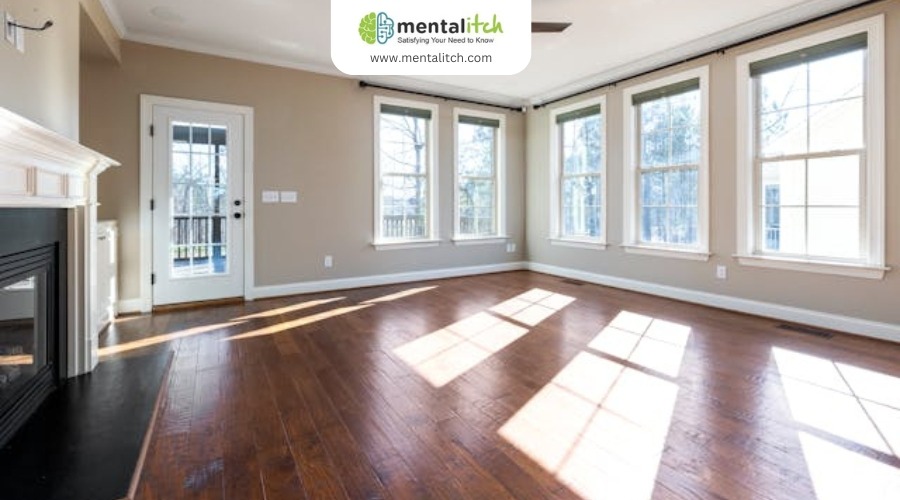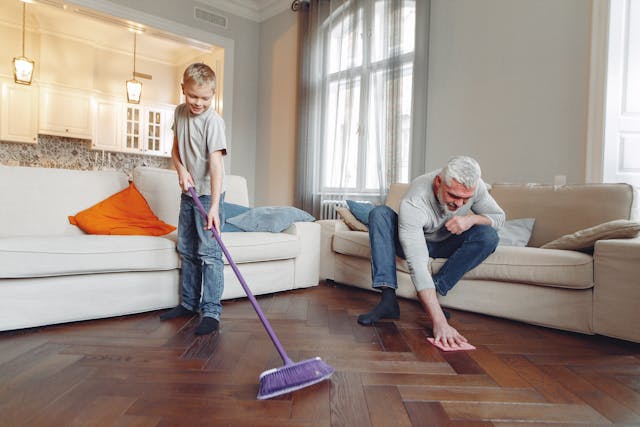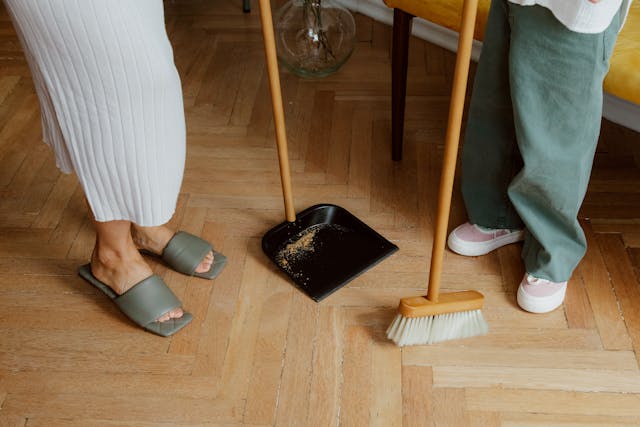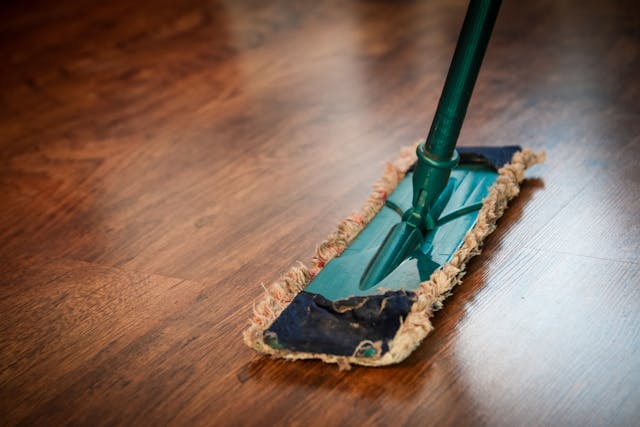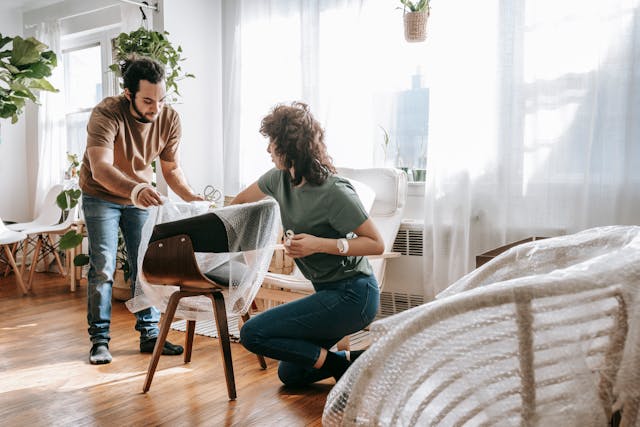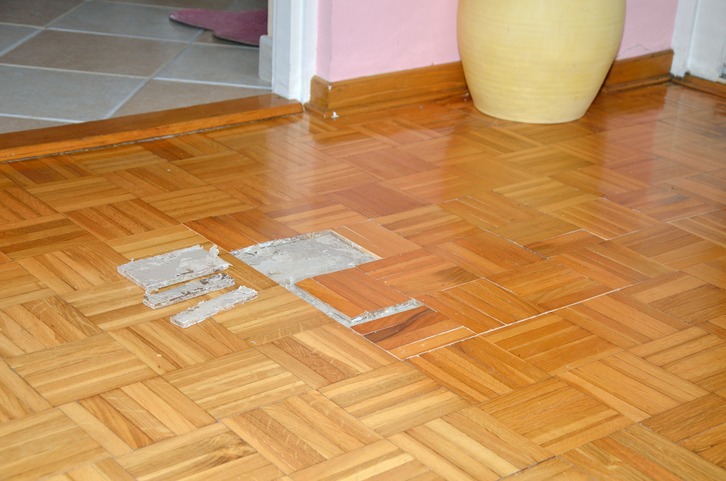Just as you’ve moved into a home with hardwood flooring, you’re likely pondering how to keep those floors looking as pristine as they did on day one. It’s crucial you don’t overlook the first steps, such as the initial cleaning that sets the stage for maintaining the floor’s integrity.
From there, you’ll need to strategize on how to prevent potential scratches and dents, which is easier said than done, especially during the hustle and bustle of moving. The key lies in the small details, like the type of mats you place at your entrance or the protective pads you attach to furniture feet.
But how exactly do these measures contribute to the longevity of your floors, and what else should you be aware of? Stay tuned, as I share some insider tips and tricks that’ll ensure your hardwood floors remain in top-notch condition, making your new house feel like a well-cared-for home.
Initial Cleaning Steps
Before settling into your new home, it’s crucial to give the hardwood floors a thorough sweep to eliminate any lingering dust, dirt, or debris. This initial step ensures you’re starting with a clean slate, making it easier to maintain the floors in pristine condition. Sweeping isn’t just about cleanliness; it’s also about safeguarding your hardwood floors from scratches or damage that can be caused by grit and grime.
Once you’ve swept away the surface dirt, it’s time to bring out a wood floor cleaner. Choosing the right cleaner is essential. You’ll want to opt for one that’s recommended for your specific type of hardwood to avoid any potential harm to the finish. This cleaner will help you tackle any stains, spills, or sticky residues without causing damage.
To further protect your hardwood floors, consider applying a fresh coat of polish or wax. This not only revives the shine but also adds a protective layer against wear and tear.
Lastly, investing in a good quality doormat to place at the entrance minimizes the amount of dirt and moisture tracked onto the floors, keeping them in top condition for longer.
Daily Maintenance Tips
After establishing a clean foundation, it’s essential to focus on daily maintenance tips to keep your hardwood floors looking their best. Regular care not only preserves the youth and beauty of your floors but also ensures their longevity and durability in your new home.
For daily cleaning, a dry dust mop is your best friend. It’s perfect for removing dust and debris without scratching the surface. Occasionally, to maintain the floor’s shine, consider using a mop soaked in a specific hardwood floor cleaner. However, it’s crucial to steer clear of wax, bleach, or abrasive cleaners as these can damage your floors rather than protect them.
Here’s a quick guide to help you remember what to do and what to avoid:
| Do | Don’t |
|---|---|
| Use a dry dust mop for daily dusting | Use wax, bleach, or abrasive cleaners |
| Occasionally use a hardwood floor cleaner | Let spills sit for too long |
| Regularly clean with proper products | Ignore the signs of wear |
| Protect floors with area rugs | Forget to use furniture sliders |
Following these simple daily maintenance tips will ensure that your hardwood floors remain a stunning feature of your new home for years to come.
Preventing Scratches and Dents
To keep your hardwood floors looking pristine, it’s crucial to focus on prevention. Start by equipping all furniture with padding and embracing regular cleaning to catch debris that can scratch the surface.
Implementing a strict shoe policy indoors further protects your floors from unnecessary wear and tear.
Furniture Padding Essentials
Protecting your hardwood floors from scratches and dents starts with choosing the right furniture pads, specifically those made of felt or rubber. These pads not only safeguard your floors but also ensure your furniture remains stable.
To effectively protect your floors:
- Ensure the pads are large enough to cover the entire bottom of furniture legs for maximum protection.
- Replace furniture pads regularly to maintain their effectiveness.
- Check and adjust furniture pads periodically to prevent dirt and debris from getting trapped, which could scratch your floors.
- Opt for pads with adhesive backing for a secure and lasting attachment.
Regular Cleaning Techniques
Beyond selecting the right furniture pads, regular cleaning plays a crucial role in keeping your hardwood floors free from scratches and dents. Use a dry dust mop for your daily cleanups to avoid dragging debris across your floors, which can cause damage.
When it’s time for a deeper clean, opt for a mop soaked in a cleaner specifically designed for hardwood flooring. This not only maintains the shine and beauty of your floors but also ensures you’re not using damaging products. Wax, ammonia, bleach, and abrasive cleaners are big no-nos, as they can cause long-term harm.
Shoe Policy Indoors
Implementing a strict no-shoes policy indoors is a key strategy for preventing scratches and dents on your hardwood flooring. When shoes are worn inside, they can track in dirt, rocks, and other debris that not only damage the floor’s finish but also lead to unsightly scratches. To protect your floor effectively:
- Establish a designated area near the entrance for shoe removal to encourage compliance.
- Regularly remind both guests and family members about the no-shoes rule to maintain the floor’s condition.
- Be mindful that high heels, cleats, and heavy boots can cause significant damage if worn indoors.
- Provide comfortable indoor footwear or slippers for occupants and visitors to promote adherence to this policy.
Immediate Spill Cleanup
To maintain your hardwood floors’ beauty and durability, it’s crucial to immediately clean up any spills. When accidents happen, grab a clean, dry cloth and gently blot the spill. It’s important not to rub, as this can push the liquid deeper into the wood, potentially causing stains or damage. Harsh cleaning agents and excessive water are big no-nos. They can harm the finish of your hardwood floors or even lead to warping. Instead, stick to mild cleaners specifically designed for hardwood and use them sparingly.
Quick action on spills not only prevents unsightly stains but also safeguards the wood’s integrity, ensuring your floors remain a stunning feature of your new home for years to come. Make it a habit to regularly inspect your floors for signs of spills or water damage. This proactive approach will help you catch and address any issues before they can cause significant harm.
Protecting Floors During Furniture Moves
When you’re moving furniture in your new home with hardwood floors, it’s crucial to protect the surface. Make sure you lift, rather than drag, furniture to avoid scratches, and consider using furniture sliders for smoother movement.
Implementing floor mats in high-traffic areas can also safeguard your floors from wear and tear.
Use Furniture Sliders
Using furniture sliders is a simple yet effective way to protect your hardwood floors during furniture moves. These essential tools are designed to reduce friction and make it easier to slide furniture without causing scratches or damage. By opting for furniture sliders, you’re not only safeguarding your floors but also making the moving process much smoother and less physically demanding.
Here’s why you should consider them:
- Furniture sliders come in various sizes and materials, suitable for different furniture legs.
- They help prevent scratches and damage to hardwood floors.
- Sliders reduce the need for lifting, minimizing back strain.
- Investing in high-quality sliders prolongs the life of your floors and furniture.
Implement Floor Mats
Investing in high-quality floor mats represents a crucial step in protecting your hardwood floors during furniture moves. Opt for mats with a non-adhesive backing to ensure your floors stay pristine, free from scratches or dents.
Strategically place these mats at entryways and high-traffic areas, creating a barrier against dirt and debris that can mar your beautiful floors. It’s wise to choose durable, shock-resistant mats capable of withstanding the weight of heavy furniture.
For added protection, consider custom-fit mats or runners along specific paths where furniture will be transported. Remember, to keep your hardwood floors in top shape, regularly clean and maintain these floor mats. They’re your hardwood floors’ best defense during those all-important moving days.
Lift, Don’t Drag
To protect your hardwood floors from scratches and damage, always lift furniture instead of dragging it during moves. When you’re faced with the task of moving furniture, it’s tempting to simply drag heavy furniture across the room. However, this can lead to dents and finish damage on your precious hardwood surfaces.
To ensure your floors remain pristine, consider the following:
- Utilize furniture sliders under heavy pieces to glide them across the floor effortlessly.
- Avoid dragging furniture at all costs to prevent unsightly scratches.
- Lift and carry furniture carefully, especially when navigating tight corners.
- Always have a plan for moving furniture, and if possible, seek assistance to distribute the weight evenly.
Repairing Damaged Hardwood
Frequently, assessing the extent of damage to your hardwood floors is the first step in the repair process. When you’re faced with repairing damaged hardwood, it’s crucial to understand the severity of scratches, dents, or stains. This will help you determine whether you can tackle the repairs yourself or if you’ll need professional assistance.
For minor issues, using wood fillers and finishing products can be remarkably effective. These products are designed to seamlessly blend with your flooring, restoring its appearance. However, if the damage is extensive, refinishing the entire floor may be the best course of action.
Here’s a breakdown of potential steps and considerations:
| Action | Consideration |
|---|---|
| Evaluate Damage | Inspect for scratches, dents, or stains. |
| DIY Repair | Use wood fillers and finishing products for minor repairs. |
| Professional Help | Seek specialists for severe damage. |
| Prevent Future Damage | Regular maintenance and care. |
Additional Details
- Be sure to check out options to shop large area rugs
Conclusion
Congratulations on your new home with hardwood flooring! Remember to start with a thorough initial clean and keep up with daily maintenance to preserve their beauty. Don’t forget to prevent scratches and dents by using protective measures, clean spills immediately to avoid damage, and be extra cautious when moving furniture.
If any part of your floor gets damaged, don’t worry—there are ways to repair it. With a bit of care, your hardwood floors will remain stunning for years to come.
